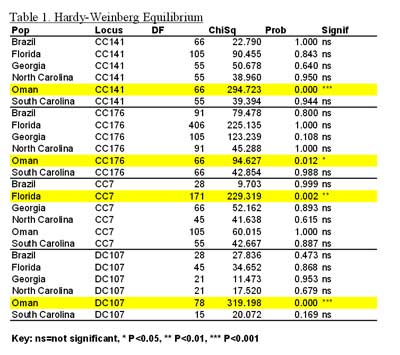Grant: 05-007R
Project Title: Integrative Marine Turtle Conservation in Florida and the Middle East
Project Manager: Dr. Christopher Parkinson
Organization: University of Central Florida (Research and Educational Institute)
Grant Amount: $13,193.00
Completion Date: 2007-09-24
Summary: This project is a joint research effort between the University of Central Florida Marine Turtle Research Group (UCFMTRG), Sultan Qaboos University (SQU), and the Oman Ministry of Nature and the Environment. Based on preliminary data, we will examine the possible genetic link between the large loggerhead rookeries of Masirah Island, Oman and Melbourne Beach, Florida. Preliminary data suggest that these rookeries share close ties and that there has been recent gene flow between them. We will use of hypervariable microsatellite loci to further examine the link between these rookeries. We will provide an international exchange of researchers during the 2005 summer season whereby graduate and undergraduate students from UCF will travel to Oman and jointly conduct marine turtle research with colleagues from SQU. Additionally, one student from SQU will intern with the UCFMTRG and participate in all aspects of their research. This international collaboration will instill a sense of global conservation in those involved. It is our hope that if these two rookeries are truly interconnected, international collaborations between these and other organizations will ensure successful, global conservation efforts in the future.  Results: We have genotyped 119 loggerheads (Caretta caretta) caught on Masirah Island, Oman, for microsatellite markers previously used in the loggerhead (Pearce 2001). Our analyses include estimates of deviations from Hardy-Weinberg Equilibrium, overall FST, pair-wise FST and Nm, Nei's genetic distance to create a tree using UPGAMA. These parameters are population genetic metrics of connectivity between populations that include both female and male-mediated gene flow. Allele frequencies for three of the four loci were significantly different from those expected under Hardy-Weinberg Equilibrium in the Oman population due in part to a low number of heterozygotes. Overall FST and Nm were surprisingly low, however this depression is due largely to comparisons of the Oman populations with others in the Atlantic. In the pairwise FST and Nm comparisons, it is clear that the estimated number of migrants (Nm) is drastically lower for all pairwise comparisons including Oman than for those between Atlantic populations. This pattern is expected given the low level of mtDNA structure between Atlantic rookeries and thus the high level of intra-Atlantic gene flow. However, the repeated (for each locus) estimate approximately 2 migrants per generation between Oman and Atlantic rookeries is significant given their geographic isolation and putative migratory patterns. Our data support the notion that Atlantic rookeries recruit loggerheads from Oman at a frequency comparable to that between Brazilian rookeries and those of the Northwestern Atlantic and Caribbean. The management implications for this level of connectivity warrant further consideration. We suggest that future efforts center on an investigation of nuclear and additional mitochondrial markers to identify the duration of this level of gene flow over recent evolutionary time. (Author: Dr. Chris Parkinson)
Results: We have genotyped 119 loggerheads (Caretta caretta) caught on Masirah Island, Oman, for microsatellite markers previously used in the loggerhead (Pearce 2001). Our analyses include estimates of deviations from Hardy-Weinberg Equilibrium, overall FST, pair-wise FST and Nm, Nei's genetic distance to create a tree using UPGAMA. These parameters are population genetic metrics of connectivity between populations that include both female and male-mediated gene flow. Allele frequencies for three of the four loci were significantly different from those expected under Hardy-Weinberg Equilibrium in the Oman population due in part to a low number of heterozygotes. Overall FST and Nm were surprisingly low, however this depression is due largely to comparisons of the Oman populations with others in the Atlantic. In the pairwise FST and Nm comparisons, it is clear that the estimated number of migrants (Nm) is drastically lower for all pairwise comparisons including Oman than for those between Atlantic populations. This pattern is expected given the low level of mtDNA structure between Atlantic rookeries and thus the high level of intra-Atlantic gene flow. However, the repeated (for each locus) estimate approximately 2 migrants per generation between Oman and Atlantic rookeries is significant given their geographic isolation and putative migratory patterns. Our data support the notion that Atlantic rookeries recruit loggerheads from Oman at a frequency comparable to that between Brazilian rookeries and those of the Northwestern Atlantic and Caribbean. The management implications for this level of connectivity warrant further consideration. We suggest that future efforts center on an investigation of nuclear and additional mitochondrial markers to identify the duration of this level of gene flow over recent evolutionary time. (Author: Dr. Chris Parkinson)
